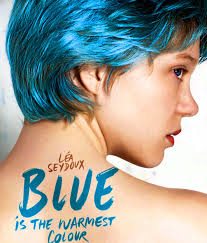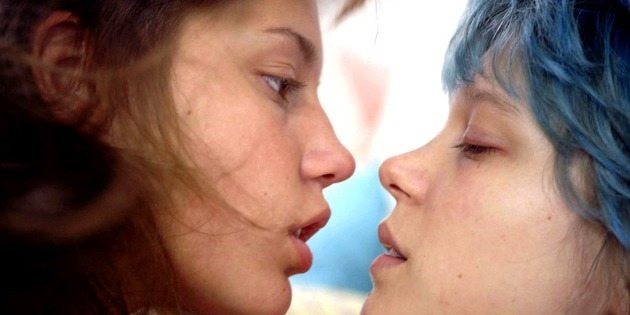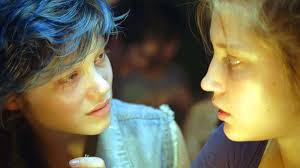The NC-17 rating. Since it’s inception in 1991 (replacing the X rating), the MPAA’s most restrictive rating has often been seen as a death sentence. Not only does the rating completely restrict those younger from 17 from seeing the film in mainstream theaters, but also most theaters simply refuse to show such films as well. It’s a rating that’s stigma alone is considered so damning towards a film’s release, that filmmakers have even surrendered their ratings rather than carry that mark of box-office death (Darron Aronofsky’s Requiem for a Dream being one of the more popular examples). Still, there are exceptions to the rule, and sometimes if a film hits enough interesting perks, it can use the rating to pique interest in it. Case in point, Abdellatif Kechiche’s new film Blue is the Warmest Colour.
When the French film premiered at Cannes 2013, it made history for being the first film screened there to win the Palme d’Or for both the director and the lead actresses. A vivid and ambitious story about a romance between two female characters, the film was championed for exploring such taboo subject matter, and for its sensitive acting and film making. Besides this, however, there was also much talk about the film’s explicit sexual content, and many people wondered if the film would indeed receive the dreaded NC-17 upon it’s release in America. Sure enough it did, but if anything that only raised interest in the film. When it premiered last Friday in select theaters in NYC and L.A., it grossed about $101,000 during the weekend with a $25,279 per theater. Seeing that it was spread across only four theaters in the country, that’s extremely impressive. Even more eyebrows were raised when New York’s IFC Center announced that they would allow high-school students to see the film (one of which included esteemed film critic A.O. Scott’s teenage daughter: here), and that in the film’s home country of France it only received roughly the equivalent of a PG-13. The attention the film has been getting is certain to make anti-censorship afficionados giddy as the day they let Howard Stern host NPR, and it’s likely the gay community will see this latest film as a breakthrough for queer cinema into the mainstream. Still, I feel that these people should pay less attention to any external nonsense the film might generate, and instead take its merits on its own.
Based on a recent graphic novel of the same name, Blue is the Warmest Colour starts out innocently enough. We’re introduced to Adèle (Adèle Exarchopoulos) a young high-school girl who we can see is having problems. She doesn’t get along with her friends, often finds herself alone in her room, and can’t seem to find herself attracted to boys. In a chance passing-by, however, she discovers Emma (Léa Seydoux) a college-age art student with bright blue-dyed hair, who she immediately becomes enthralled with. Upon meeting her on her first visit to a lesbian bar, the two quickly bond, and their friendship transitions into love. From there, the film follows the relationship these two have over the next few years.
Blue is the Warmest Colour is a film that will immediately strike a chord with today’s youth. Avoiding flashy camera-work, the film mostly captures the environment of daily teenage life through extreme close-ups, that definitely makes the film seem personal. Avoiding too much use of external music in the film, as well as artificial lighting, it could be said that the overall look is natural, and potentially timeless. Still, the film has plenty of references to the past, particularly in regards to literature. Sartre is referenced by Emma as one of her most beloved philosophers, and Adèle says her favorite book is La Vie de Marianne. The allusions may not be entirely subtle, but it’s a nice touch of reminding us that Adèle falls into a long line of romantic heroines (i.e. Anna Karenina)
Both the actresses in the film’s give sensational performances, with particular attention going to Exarchopoulos. The 19-year old actress appears in literally every scene within the film’s sprawling three-hour length, yet not once does she slip in her ability to hold our attention, nor break character. Adèle gives off a great mood of uncertainty and sorrow for her initial scenes, then effortlessly transforms her mannerisms to reflect the joy and arousal she feels after meeting Emma. Léa Seydoux is also a real stunner as Emma, making the character instantly likable, and proving as a wiser and more experienced love interest for the young and naive Adèle. Hell, both actresses should receive enough applause alone for choosing to star in such an edgy film so early in their career as well.
Which does of course bring us to the sex scenes, and in honesty I feel that some of the criticism to it isn’t unfounded. Yes, they are considerably lengthy, as about 15 minutes of Blue is the Warmest Colour is dedicated to love-making, while Raging Bull had about 10 minutes of boxing in it. Also, yes they are explicit, and Kechiche doesn’t skimp on positions and moves her two young actresses can perform on each other. I did find myself wondering if the film needed to present sexuality this up-front and frequent, as I often feel that sex scenes in movies are better done sub-dued, and leaving much to the imagination (I feel Cronenberg does it better than most). Still, it was equally hard to fault the film for including these scenes, as it was trying to be such an honest portrayal of young love. Seeing these two young naked females sprawled upon each other in rapturous displays could certainly feel voyeuristic at times, but it also gave us a better understanding of Adele’s passion towards Emma, a woman who seemed to have truly allowed her to live for the first time in her life. In fact, it might have even made the sex scenes that made the film’s more emotional scenes in the final act really resonate.
The film’s French title translates to The Life of Adele: Chapters 1 + 2, and after I found this out (following the film’s open-ended finale) I began to wonder if that meant that Kechiche had intended for this film to have a sequel to it. Of course, after I took the time to really think about it I realized how naive a thought this was. The title merely symbolizes that this film focuses on the beginning of Adele’s life, and that it will certainly continue past the time the credits roll, it’s just we won’t be witnessing it anymore. Holding that card, I feel that Blue is the Warmest Colour acts as a vivid and spirited reminder to us on the stages we go through during life, and how it can all mean so much to us both in the singular moment, as well as spread out over a life-time. So whether you choose to see this film for it’s controversy, or whether the film itself interests you, I hope that you’ll be able to take away such a notion as you leave the theater. Blue is the Warmest Colour is exactly the type of foreign film we need to spike the Oscar race up a little bit this year.



